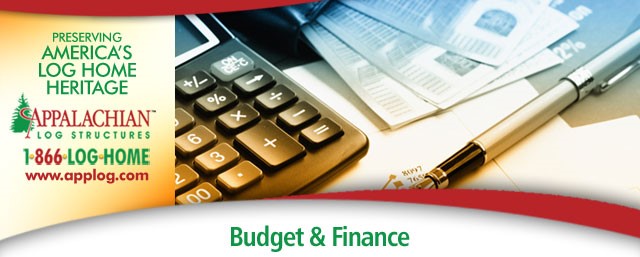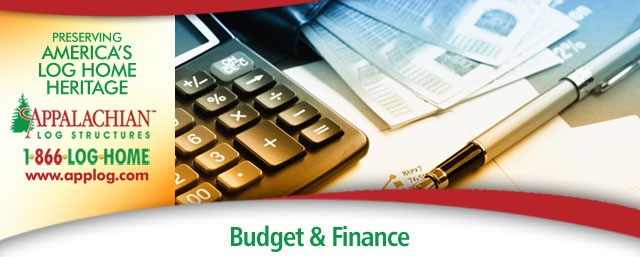
This 3-part series on Financing your Dream Log Home was co-written by Greg Ebersole, Mortgage Loan Officer/BB&T and Donald Parsons, Appalachian Log Structures. Mr. Ebersole has over 16 years in the Mortgage Lending field and specializes in Log Home financing. Mr. Parsons has spent the last 23 years assisting several hundred satisfied homeowners realize their dream log homes with Appalachian Log Structures.
In recent years, the financing of new custom homes has transformed due to changes in the marketplace, increased government regulations and lower interest rates. In order to assist in the navigation of these new financing rules and regulations this 3-part article was developed to help guide people on the path to realizing their dream log home.
Part 1 will focus on the individuals FICO score, Credit Report and Pre-qualification process. You will learn what they mean in the overall development of your loan amount and possible interest rate both in the construction phase of the building project as well as in permanent financing. You can prepare yourself with most of this knowledge before going to the lender so you have a better idea of just where you stand financially.
Part 2 will discuss how to search for a “log friendly” lending institution and starting the floor plan drawing process. Although some banks or mortgage companies make construction loans on conventional built homes, there are some unique features of log home lending that not all institutions may understand or agree to. You’ll also discover why it’s important to get your floor plans started now!
Part 3 will cover what to expect at loan closing as well as getting a good appraisal on your project.
Part 1:
FICO scores, Credit Reports and Pre-Qualification – OH MY!
What is a FICO Score? A FICO score is a credit score developed by FICO, a company that specializes in what’s known as “predictive analytics,” which means they take information and analyze it to predict what’s likely to happen.
In the case of credit scores, FICO takes credit information and uses it to create scores that help lenders predict behavior, such as how likely someone is to pay their bills on time (or not), or whether they are able to handle a larger credit line. Scores developed by FICO can also be used to forecast which accounts are most likely to end up included in bankruptcy, or which ones are likely to be most profitable. And credit-based insurance scores, which they also create, are used to help insurance companies identify which customers are least likely to file claims.
What Goes Into FICO Scores?
The FICO score range is 300 – 850, with the higher number representing less risk to the lender or insurer. Consumers with high FICO scores (usually around 760 or higher, though every lender is different) are likely to get the best rates when they borrow, as well as the best discounts on insurance.
There is a popular FICO score chart that describes the main factors that go into these scores:
Payment History (35%)
Debt/Amounts Owed (30%)
Age of credit history (15%)
New credit/inquiries (10%)
Mix of accounts/types of credit (10%)
All of these factors are considered in other credit score models, so it’s safe to say that if you have a strong FICO score you likely have a good score with other models as well. When you check your credit score, don’t get too hung up on the specific number. Instead, focus on what areas of your credit are strong and which ones you might want to work on.
What is a Credit Score? A credit score is a three digit number calculated from your data-rich credit report and is one factor used by lenders to determine your creditworthiness for a mortgage, loan or credit card. Your score can affect whether or not you are approved as well as what interest rate you are charged.
Mr. Ebersole says “Construction lending typically has higher credit score requirements than purchasing or refinancing an existing home. Knowing your credit scores can help when having your initial call with a mortgage lender. Some credit card companies such as Discover now provide you a credit score from one of the credit reporting agencies. Please note that your lender will pull all 3 credit bureau’s (Equifax, Experian & TransUnion) and use the middle score (drop the highest & lowest scores) for determining the loan program available as well as the rates. You can also request credit scores from places like freecreditreport.com. However, I caution clients in using these scores as the assumption for scores when trying to secure a mortgage. If you only get 1 of the 3 credit scores you will not know if that score is your highest, lowest or middle score. There are over 200 different scoring matrixes used to determine scores based on the use of the credit inquiry. My experience has shown that “free” credit report scores are typically 10-40 points higher than when a lender pulls the credit report. If you are not aware of any late payments, charge-offs, collections or judgements in the past 5 years your credit scores are likely to be over 700.”
Once you understand what goes in to both a FICO and Credit Score and how important they are in the process, you can then begin the pre-qualification stage. Please keep in mind that pre-qualification does not necessarily mean this is what a financial institution will lend, only a quick (un-verified) overview of your current income and liabilities to determine a possible loan amount. Mr. Ebersole explains that “the first step in the financing process will be completing a pre-qualification. To prequalify the lender will need basic information such as your full name, address, date of birth and social security number. This information will be used to acquire a credit report to use in evaluating your current debts as noted in the credit report. Additionally, the lender will ask for income information. Based on the debts from the credit report and income provided the lender will give you a pre-qualification noting the mortgage loan amount you can qualify for at this time. This is helpful information to use as you plan your search for land (if not already owned) and planning of your loan home. Another consideration in the pre-qualification process will be the amount of monies available for down payment and closing costs. The equity in your land can go towards your down payment depending on the appraisal that comes back during the approval process.” CLICK HERE to start the pre-qualifying process with BB&T today!
To help you save money on the Financing process, BB&T has a great offer for you. CLICK HERE to learn more about saving up to a $1000 on Lending Fees with BB&T.
Be sure to check back next week to view Part 2 of this Financing Series.



.png?width=137&height=70&name=blue-seal-120-61-bbb-21001218%20(1).png)